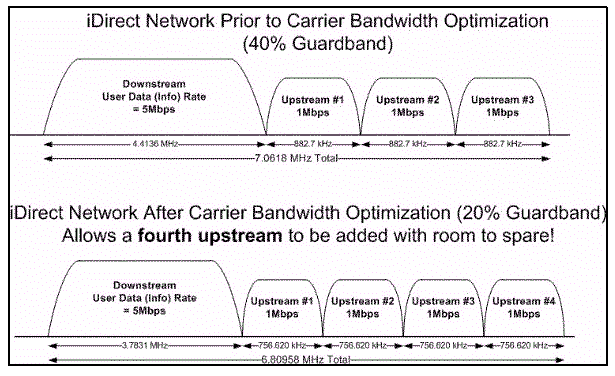Post by Eric Johnston on Jan 30th, 2013 at 11:36am
You need to read your iDirect documentation.
This extract from an old document may still be valid:
From "Technical Reference Guide iDS Release 7.x" page 107
"For example, consider an iDirect network with a user data (information) rate of 5Mbps on the downstream and three upstream carriers of 1Mbps each. FEC rate 0.793 with 4kbit TPC is used for all carriers in this example. Figure 32 on page 107 shows that an additional Upstream carrier may be added by reducing the channel spacing of the existing carriers.
"
You must start with the bit rate, FEC ratio and modulation method used on each of your carriers. I suggest you make your own spreadsheet to work out the centre frequencies of each carrier.
Example calculation (second carrier, "Upstream #1", lower figure):
Information bit rate = 1 Mbit/s
FEC = 0.793
Transmission bit rate = 1 / 0.793
Symbol rate = 1 / (0.793 * 2) , assuming QPSK
Carrier spacing = 1.2 x Symbol rate = 756.62 kHz.
At the edges of your leased transponder bandwidth your satellite operator may insist on a 1.4 factor being used.
The iDirect hardware/software may have a minimum incremetal step size applicable to setting the frequencies.
A larger gap between your outlink and the adjacent return link may be appropriate if the spectral densities differ significantly.
This extract from an old document may still be valid:
From "Technical Reference Guide iDS Release 7.x" page 107
"For example, consider an iDirect network with a user data (information) rate of 5Mbps on the downstream and three upstream carriers of 1Mbps each. FEC rate 0.793 with 4kbit TPC is used for all carriers in this example. Figure 32 on page 107 shows that an additional Upstream carrier may be added by reducing the channel spacing of the existing carriers.
"
You must start with the bit rate, FEC ratio and modulation method used on each of your carriers. I suggest you make your own spreadsheet to work out the centre frequencies of each carrier.
Example calculation (second carrier, "Upstream #1", lower figure):
Information bit rate = 1 Mbit/s
FEC = 0.793
Transmission bit rate = 1 / 0.793
Symbol rate = 1 / (0.793 * 2) , assuming QPSK
Carrier spacing = 1.2 x Symbol rate = 756.62 kHz.
At the edges of your leased transponder bandwidth your satellite operator may insist on a 1.4 factor being used.
The iDirect hardware/software may have a minimum incremetal step size applicable to setting the frequencies.
A larger gap between your outlink and the adjacent return link may be appropriate if the spectral densities differ significantly.
